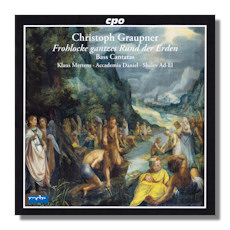
The Internet's Premier Classical Music Source
Related Links
- Graupner Reviews
- Latest Reviews
- More Reviews
-
By Composer
-
Collections
DVD & Blu-ray
Books
Concert Reviews
Articles/Interviews
Software
Audio
Search Amazon
Recommended Links
Site News
 CD Review
CD Review
Christoph Graupner

Bass Cantatas
- Frohlocke gantzes Rund der Erden, GWV 1139
- Ich bin zwar Asch und Koth, GWV 1135/13
- Ach Herr mich armen Sünder, GWV 1152/46
- Kommt, last uns mit Jesu gehen, GWV 119/22
- Angenehmenes Waßer Bad, GWV 1104/11b
- Zähle meine Flucht, GWV 1154/12b
Klaus Mertens, bass-baritone
Accademia Daniel/Shalev Ad-El
CPO 777644-2
Christoph Graupner lived from 1683 to 1760 and was thus a close contemporary of J.S. Bach, Handel and Telemann. Indeed, he studied with Johann Kuhnau, who was Thomaskantor in Leipzig immediately before Bach – from 1701 to 1722. In fact Graupner was nearly appointed to the post that Bach actually held; but, like Telemann, withdrew when the salary for his existing post, Hofkapellmeister (court chapel master) at the court of Hesse-Darmstadt, was increased. Although the bass cantatas on this CD from cpo are clearly of Bach's world, their transparency, simple declamation and an emphasis on a more linear tonality differentiate them; place their musical thrust closer to Telemann than either Bach or Handel.
Israeli conductor and harpsichordist, Shalev Ad-El, who was born in 1968, conducts the Accademia Daniel which he founded in 1995 in five sacred cantatas of between about 10 and 13 minutes each. They were all composed between 1711 and 1746 for the Darmstadt court. Graupner wrote an almost unbelievable 45 annual cycles, 1,400 cantatas; additionally he wrote nearly 50 for solo tenor, soprano and bass.
Bass-baritone Klaus Mertens, who celebrated his 65th birthday in 2014, is the soloist. With over 150 recordings to his credit, his maturity and experience are beyond doubt. At the same time some listeners, while admiring his impeccable diction and enunciation of the texts (variously by contemporary theologian Johann Conrad Lichtenberg (1689-1751) and novelist and poet Georg Christian Lehms (1684-1717), who also wrote as "Pallidor"), may detect a slight flatness, lack of luster and incipient thinning of his voice. The otherwise lively and uplifting closing chorale of "Ach Herr mich armen Sünder" [tr.19], for instance, seems to be dragged slightly downwards by Mertens vocal line.
Graupner's music is sufficiently lacking in challenging ornament or contrapuntal drive for this not to matter too much to many. It's beautiful and persuasive music otherwise sung persuasively and with conviction. The cantatas take the form of alternating aria/arioso and recitative, some with a (closing) chorale, some introduced by a short biblical Dictum. Although there are also some da capo form arias, redolent of Italian opera, there is a good deal of restraint and self-possession in the music. They lack the complexity and depth of Bach's cantatas. But these musicians neither play down Graupner's achievement, nor attempt to fill in the hollows by excessive drama or spurious liveliness. The performances are thus very honest ones. Color is not lacking. Nor precision. The inward-looking confessional power is to the fore at all times, which was the cantatas' chief purpose.
In fact there are many moments when the very lightness and directness of the composer's writing is of real moment and impact – in that same closing chorale of Ach Herr mich armen Sünder [tr.19], for instance. The players and Martens have just the right touch too. Then the passages where tenderness and sensitivity are particularly evident… the aria, "Erkläre mir" from "Komm, lasst uns mit Jesu gehen" [tr.22] is a good example: here Mertens brings a delicacy and grace to the progress of the cantata that adds understanding and pleasure in our appreciation of the suffering described. Yet without (self-)pity or undue regret.
As the cantatas unfold throughout the disk so the variety of emotions is carefully underpinned by this sensitive playing and singing. A lightness of touch, as opposed to rhetorical bombast even in the affirmatory moments ensures that it is Graupner first and a modern interpretation only secondarily. At the same time, the intricacies of a performance on period instruments are not artificially elided. It's probably the small size (a maximum of nine players at any one time) that accounts for the pleasing precision which we hear throughout this CD.
The acoustic of the CD is good: not a spare artefact is to be heard to distract us from the music. The booklet is well up to cpo's usual standards with information about Graupner, the performers, and complete texts in German and English. Graupner is a rich source of High Baroque music to mine. These are the only recordings of each of these cantatas currently available. Although not having the caché of Bach's works in the same medium, or even Telemann's, these are enjoyable pieces, performed for the most part well. Enthusiasts for Graupner will want to get it for its value as much more than a curiosity.
Copyright © 2014, Mark Sealey




















